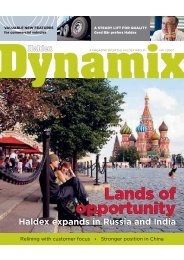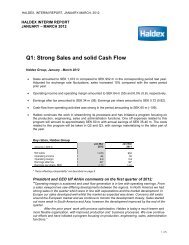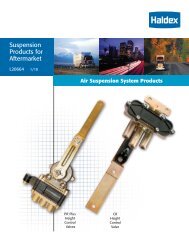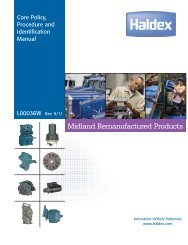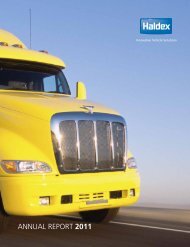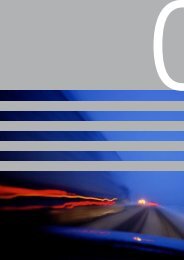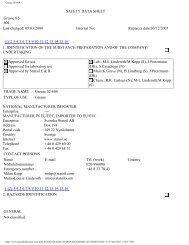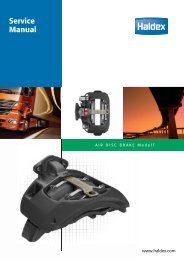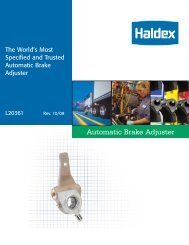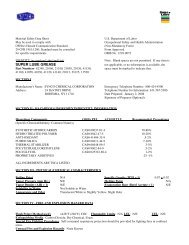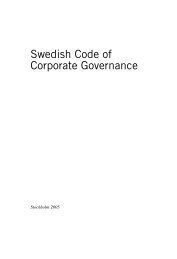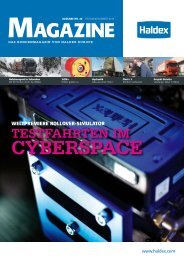Bardahl de Mexico, SA de CV - Haldex
Bardahl de Mexico, SA de CV - Haldex
Bardahl de Mexico, SA de CV - Haldex
You also want an ePaper? Increase the reach of your titles
YUMPU automatically turns print PDFs into web optimized ePapers that Google loves.
Page 1<br />
<strong>Bardahl</strong> <strong>de</strong> <strong>Mexico</strong>, <strong>SA</strong> <strong>de</strong> <strong>CV</strong> <strong>Bardahl</strong> HDS 2, Bital, AUTOMATIC TRANSMISSION<br />
SECTION I. <strong>SA</strong>FETY DATA SHEET<br />
Manufacturer Name: <strong>Bardahl</strong> <strong>de</strong> <strong>Mexico</strong>, <strong>SA</strong> <strong>de</strong> <strong>CV</strong><br />
Address: Eje 1 Norte No. 16 Parque Industrial Toluca 2000, Toluca Edo. <strong>Mexico</strong><br />
Telephones: 01 722 279-00-49/79, Ext 1013.<br />
In the event of chemical emergency (spill, leak, fire, explosion or acci<strong>de</strong>nt) SETIQ call 01 800 00 214 00 and<br />
in <strong>Mexico</strong> City 5559 1588<br />
SECTION II. GENERAL INFORMATION ON THE CHEMICAL SUBSTANCE<br />
Name: <strong>Bardahl</strong>, <strong>Bardahl</strong> 2 / Bital / ADDITIVE FOR AUTOMATIC TRANSMISSION<br />
Chemical Family: Hydrocarbons<br />
Synonyms: Stabilizer additive viscosity engine oil and automatic transmission<br />
DEGREE OF RISK<br />
4) EXTREME<br />
3) HIGH<br />
2) MODERATE<br />
1) LIGHT<br />
0) NO RISK<br />
SECTION III. IDENTIFICATION OF THE SUBSTANCE (COMPONENTS)<br />
NFPA CODE Degree of risk<br />
Name of components CAS Number Health Flammability Reactivity Specials<br />
Basic Oils Mixture 1 1 0 ND<br />
Additives confi<strong>de</strong>ntial Mixture ND ND ND ND<br />
SECTION IV. PHYSICOCHEMICAL PROPERTIES<br />
Boiling Point (°C) >300 Melting point (°C) NA<br />
Ignition temperature 220 225 Auto Ignition Temperature (°C) ND<br />
Specific gravity at 15.6 °C 0,884 to 0,886 Molecular Weight ND<br />
Evaporation rate (butyl-- Insignificant Physical State Translucent Liquid<br />
ACETATE = 1) Color Orange, Amber<br />
Vapor Pressure (mm Hg 20° C)
<strong>Bardahl</strong> <strong>de</strong> <strong>Mexico</strong>, <strong>SA</strong> <strong>de</strong> <strong>CV</strong> <strong>Bardahl</strong> HDS 2, Bital, AUTOMATIC TRANSMISSION<br />
Respiratory protection: First find out if airborne concentrations exceed exposure limits,<br />
Recommen<strong>de</strong>d if they are above the limit, then use a respirator with in<strong>de</strong>pen<strong>de</strong>nt air supply.<br />
Procedures and precautions in fighting fire<br />
Isolate hazard area; remove containers that have not been affected, use water in a spray to cool<br />
containers exposed to fire, if the liquid has been spilled and ignited do not apply water directly,<br />
spatter can cause burns to others or yourself.<br />
Conditions that lead to another special hazard: None given at this time. Un<strong>de</strong>r conditions<br />
normal operation, the product is highly stable.<br />
Combustion products harmful to health: It is incomplete combustion produces CO, CO2 and hydrocarbons<br />
Light-type flammable.<br />
SECTION VI. REACTIVITY DATA<br />
Substance: Conditions to avoid:<br />
(√) Stable Unstable Avoid sources of heat or spark.<br />
Incompatibility (Substance to avoid): Hazardous <strong>de</strong>composition products.<br />
Avoid contact with powerful oxidizers. Un<strong>de</strong>r normal conditions does not <strong>de</strong>compose.<br />
Spontaneous Polymerization:<br />
Could Happen (√) Can not occur<br />
Page 2<br />
SECTION VII. RISKS TO HEALTH<br />
VII A. Health Effects<br />
Primary routes of exposure. The possible routes of entry into the liquid state are skin and ingestion, while the route<br />
of entry for gases is by eye, skin and inhalation.<br />
Effects on exposure.<br />
Skin: Contact may be some temporary mild irritation, prolonged contact may cause <strong>de</strong>rmatitis and<br />
tumefaction even in people with highly sensitive skin.<br />
Eyes: Splashes of hot oil are required to be served by a doctor.<br />
Inhalation: Mineral oil mists at concentrations greater than those allowed in poorly ventilated areas may<br />
cause respiratory tract irritation, headache, nausea and drowsiness.<br />
Ingestion: Quantities as a drink or two can cause abdominal pain, nausea and diarrhea.<br />
Chronic effects: So far, no serious damage has been documented in humans by chronic exposure.<br />
Other effects: Leakage from high pressure equipment can penetrate the skin and if there is no treatment<br />
a<strong>de</strong>quate can cause serious injuries such as loss of function and even amputation of the member warrant<br />
affected.<br />
When the product is heated begins to emit vapors, which aspire to for prolonged periods can<br />
damage the lungs, causing irritation to the respiratory tract, eyes and central nervous system, causing<br />
drowsiness, dizziness, nausea, blurred vision, headache, vomiting, loss of consciousness, difficulty<br />
talking, abnormal heart rhythm and / or seizures.<br />
Chemical consi<strong>de</strong>red:<br />
ND Carcinogen ND Mutagenic ND Teratogenic<br />
Information:<br />
ND CL50 ND DL50<br />
VII B. Emergency and First Aid<br />
Eye Contact: Flush with water holding eyelids to ensure the cleanliness of the whole<br />
eye, see a doctor immediately.<br />
Skin contact: Remove soaked clothing immediately, wash with soap and water in abundance, if<br />
irritation consult a doctor. Burns should be treated by a doctor.<br />
Date of preparation: October 1999 Revision Date: February 2006 Level of Review: 03 Page 2 of 3
Page 3<br />
<strong>Bardahl</strong> <strong>de</strong> <strong>Mexico</strong>, <strong>SA</strong> <strong>de</strong> <strong>CV</strong> <strong>Bardahl</strong> HDS 2, Bital, AUTOMATIC TRANSMISSION<br />
Ingestion: Do not induce vomiting can cause aspiration bronco and therefore pneumonitis. Check<br />
difficulty breathing. See your doctor immediately.<br />
Inhalation: Remove the affected person and transpórtela to a cool, see if there is difficulty breathing.<br />
Apply oxygen or artificial respiration, if necessary. Call your doctor immediately.<br />
Other risks or health effects: Not known.<br />
Data for the doctor: Suctioning of oil mists may cause severe pneumonitis, patients should<br />
be monitored for possible long-term effects. Prolonged aspiration of small amounts of vapor<br />
oil may cause pulmonary inflammation that progressively can generate pulmonary fibrosis. Symptoms<br />
can begin as persistent cough, <strong>de</strong>creased respiratory capacity, respiratory tract irritation, fever<br />
and / or spit blood.<br />
Antidote: Not Available.<br />
SECTION VIII. INDICATIONS FOR SPILL OR LEAK<br />
Isolate and i<strong>de</strong>ntify the danger zone; keep anyone unnecessarily away.<br />
Eliminate any source of ignition. Stand on the si<strong>de</strong> of the wind.<br />
Leaks or spills must be contained and covered with sand, special pads are then<br />
prepared in accordance with applicable local laws.<br />
You must use appropriate breathing apparatus (if necessary), gloves and protective clothing during<br />
cleaning.<br />
Avoid the arrival of the spill to any aquifer, river, lake, etc. If you could not avoid notify<br />
immediately to local authorities.<br />
SECTION IX. SPECIAL PERSONAL PROTECTION<br />
Eye protection and / or facial: We recommend using safety glasses or face shields.<br />
Protection for the skin: Wear suitable gloves for handling chemicals (Nitrile).<br />
Respiratory protection: If you keep a flow of fresh air during the handling is not necessary, if<br />
otherwise use respirator with in<strong>de</strong>pen<strong>de</strong>nt air supply.<br />
SECTION X. TRANSPORTATION INFORMATION<br />
So far no information on the subject<br />
SECTION XI. INFORMATION ON ECOLOGY<br />
It should consult with local laws and remain in effect. NO DOWNLOAD drainage.<br />
SECTION XII. SPECIAL PRECAUTIONS<br />
The containers containing the product must be i<strong>de</strong>ntified, closed, cold and dry.<br />
Do not store the product in areas with extreme temperatures; keep in cool and well ventilated areas<br />
away from any source of ignition, heat or spark.<br />
Do not drink, eat or smoke in storage areas.<br />
Do not fill containers with other products, do not use containers for different purposes for which they<br />
were <strong>de</strong>signed.<br />
Containers may retain product residue which may be flammable or combustible; no cutting,<br />
grinding and / or sol<strong>de</strong>ring unless they have taken the necessary precautions.<br />
Date of preparation: October 1999 Revision Date: February 2006 Level of Review: 03 Page 3 of 3
<strong>Bardahl</strong> <strong>de</strong> México, S. A. <strong>de</strong> C.V. HDS BARDAHL 2, BITAL, TRANSMISION AUTOMATICA<br />
SECCIÓN I. HOJA DE DATOS DE SEGURIDAD<br />
Nombre <strong>de</strong>l fabricante: <strong>Bardahl</strong> <strong>de</strong> México, S.A. <strong>de</strong> C.V.<br />
Domicilio: Eje 1 Norte No. 16 Parque industrial Toluca 2000, Toluca Edo. <strong>de</strong> México<br />
Teléfonos: 01 722 279-00-49/79, Ext. 1013.<br />
En caso <strong>de</strong> emergencia química (<strong>de</strong>rrame, fugas, incendio, explosión o acci<strong>de</strong>nte) llamar al SETIQ 01 800 00 214 00 y<br />
en el D.F. 5559 1588<br />
SECCIÓN II. DATOS GENERALES DE LA SUSTANCIA QUÍMICA<br />
Nombre Comercial: <strong>Bardahl</strong> <strong>Bardahl</strong> 2 / BITAL / ADITIVO PARA TRANSMISION AUTOMATICA<br />
Familia Química: Hidrocarburos<br />
Sinónimos: Aditivo estabilizador <strong>de</strong> la viscosidad <strong>de</strong>l aceite <strong>de</strong>l motor y para la transmisión automática<br />
SECCIÓN III. IDENTIFICACIÓN DE LA SUSTANCIA (COMPONENTES)<br />
GRADO DE RIESGO<br />
4) EXTREMO<br />
3) ALTO<br />
2) MODERADO<br />
1) LIGERO<br />
0) SIN RIESGO<br />
CÓDIGO NFPA<br />
Nombre <strong>de</strong> los componentes Número CAS<br />
Grado <strong>de</strong> riesgo<br />
Salud Inflamabilidad Reactividad Especiales<br />
Aceites básicos Mezcla 1 1 0 ND<br />
Aditivos confi<strong>de</strong>nciales Mezcla ND ND ND ND<br />
SECCION IV. PROPIEDADES FISICOQUÍMICAS<br />
Temperatura <strong>de</strong> ebullición (°C) > 300 Temperatura <strong>de</strong> fusión (°C) NA<br />
Temperatura <strong>de</strong> inflamación (°C) 220 a 225 Temperatura <strong>de</strong> auto ignición (°C) ND<br />
Gravedad específica a 15.6°C 0.884 a 0.886 Peso Molecular ND<br />
Velocidad <strong>de</strong> evaporación (BUTIL - Insignificante Estado físico<br />
Líquido translucido<br />
ACETATO = 1)<br />
Color<br />
Naranja, ámbar<br />
Presión <strong>de</strong> Vapor (mm Hg 20°C) < 0.1 mm Hg Olor Similar al petróleo<br />
Limites <strong>de</strong> inflamabilidad o<br />
explosividad<br />
Solubilidad en agua Insoluble<br />
Inferior ND % <strong>de</strong> volatilidad ND<br />
Superior ND<br />
ND No Detectado NA No Aplica Tip. Típico<br />
INFLAMABILIDAD<br />
RIESGOS<br />
ESPECIALES<br />
SECCIÓN V. RIESGOS DE FUEGO O EXPLOSIÓN<br />
REACTIVIDAD<br />
Medio <strong>de</strong> extinción:<br />
� Niebla � Espuma � CO2 � Polvo Químico seco � Arena � Chorro <strong>de</strong> agua<br />
Equipo <strong>de</strong> protección personal:<br />
Ojos. Use lentes <strong>de</strong> seguridad, goggles y/o careta <strong>de</strong> protección.<br />
Piel. No se necesita ropa especial pero tome las precauciones necesarias en caso <strong>de</strong> salpicaduras.<br />
Fecha <strong>de</strong> elaboración: Octubre 1999 Fecha <strong>de</strong> revisión: Febrero 2006 Nivel <strong>de</strong> Revisión:03 Página 1 <strong>de</strong> 3<br />
<strong>SA</strong>LUD<br />
1<br />
1 0
<strong>Bardahl</strong> <strong>de</strong> México, S. A. <strong>de</strong> C.V. HDS BARDAHL 2, BITAL, TRANSMISION AUTOMATICA<br />
Protección respiratoria. Primeramente investigue si la concentración <strong>de</strong> vapores supera los límites <strong>de</strong> exposición<br />
recomendados, si estos están por arriba <strong>de</strong>l límite entonces use un respirador con suministro <strong>de</strong> aire in<strong>de</strong>pendiente.<br />
Procedimiento y precauciones especiales en el combate <strong>de</strong> incendio:<br />
Aísle el área <strong>de</strong> peligro, retire los contenedores que no han sido afectados, use agua en forma <strong>de</strong> rocío para enfriar los<br />
contenedores que están expuestos al fuego, si el líquido se ha <strong>de</strong>rramado e inflamado no aplique agua en forma directa,<br />
pue<strong>de</strong> salpicar y causar quemaduras a otras personas o a usted mismo.<br />
Condiciones que conducen a otro riesgo especial: Ninguna <strong>de</strong>terminada por el momento. Bajo condiciones<br />
normales <strong>de</strong> manejo, el producto es altamente estable.<br />
Productos <strong>de</strong> la combustión nocivos para la salud: Por combustión incompleta se produce CO, CO2 e hidrocarburos<br />
ligeros <strong>de</strong> tipo inflamable.<br />
Sustancia:<br />
� Estable Inestable<br />
Incompatibilidad (Sustancia a evitar):<br />
Evite el contacto con oxidantes po<strong>de</strong>rosos.<br />
Polimerización espontánea:<br />
Pue<strong>de</strong> Ocurrir � No pue<strong>de</strong> ocurrir<br />
SECCIÓN VI. DATOS DE REACTIVIDAD<br />
SECCIÓN VII. RIESGOS PARA LA <strong>SA</strong>LUD<br />
VII A. Efectos sobre la salud<br />
Condiciones a evitar:<br />
Evitar fuentes <strong>de</strong> calor o chispa.<br />
Productos peligrosos <strong>de</strong> la <strong>de</strong>scomposición:<br />
En condiciones normales no se <strong>de</strong>scompone.<br />
Rutas <strong>de</strong> exposición primarias. Las posibles rutas <strong>de</strong> entrada en estado líquido son piel e ingestión; mientras que la<br />
ruta <strong>de</strong> entrada para gases es por ojos, piel e inhalación.<br />
Efectos sobre exposición.<br />
Piel. Por contacto temporal se pue<strong>de</strong> presentar alguna irritación leve; el contacto prolongado pue<strong>de</strong> causar <strong>de</strong>rmatitis e<br />
incluso tumefacción en personas con piel altamente sensible.<br />
Ojos. Salpicaduras <strong>de</strong> aceite caliente requieren ser atendidas por un médico.<br />
Inhalación. Nieblas <strong>de</strong> aceite mineral con concentraciones mayores a las permitidas en lugares mal ventilados pue<strong>de</strong><br />
provocar irritación <strong>de</strong> las vías respiratorias, cefalea, nauseas y somnolencia.<br />
Ingestión. Cantida<strong>de</strong>s como un trago o dos pue<strong>de</strong>n provocar dolor abdominal, nauseas y diarrea.<br />
Efectos crónicos. Hasta el momento no se ha documentado efectos graves en humanos por exposición crónica.<br />
Otros efectos. Fugas provenientes <strong>de</strong> equipos <strong>de</strong> alta presión pue<strong>de</strong>n penetrar la piel y si no se tiene un tratamiento<br />
a<strong>de</strong>cuado pue<strong>de</strong> provocar lesiones graves tales como pérdida <strong>de</strong> funciones e incluso ameritar amputación <strong>de</strong>l miembro<br />
afectado.<br />
Cuando el producto es calentado comienza a emitir vapores, los cuales al aspirarlos por periodos prolongados pue<strong>de</strong>n<br />
dañar los pulmones, causar irritación en el tracto respiratorio, ojos y el sistema nervioso central; ocasionando<br />
somnolencia, mareo, nausea, visión borrosa, dolor <strong>de</strong> cabeza, vómito, posible pérdida <strong>de</strong> la conciencia, dificultad para<br />
hablar, alteración <strong>de</strong>l ritmo cardiaco y/o convulsiones.<br />
Sustancia Química consi<strong>de</strong>rada:<br />
__ND__ Carcinogénica __ND__ Mutagénica __ND__ Teratogénica<br />
Información complementaria.<br />
__ND__ CL50 __ND__ DL50<br />
VII B. Emergencias y primeros auxilios<br />
Contacto con los Ojos. Lave con agua abundante sosteniendo los párpados para asegurar la limpieza <strong>de</strong>l globo<br />
ocular, consultar al médico inmediatamente.<br />
Contacto con la piel. Quítese la ropa impregnada inmediatamente, lávese con agua y jabón en abundancia, si hay<br />
irritación consulte al médico. Las quemaduras <strong>de</strong>ben ser atendidas por un médico.<br />
Fecha <strong>de</strong> elaboración: Octubre 1999 Fecha <strong>de</strong> revisión: Febrero 2006 Nivel <strong>de</strong> Revisión:03 Página 2 <strong>de</strong> 3
<strong>Bardahl</strong> <strong>de</strong> México, S. A. <strong>de</strong> C.V. HDS BARDAHL 2, BITAL, TRANSMISION AUTOMATICA<br />
Ingestión. No provoque el vómito, pue<strong>de</strong> provocar bronco aspiración y por consecuencia neumonitis. Observe si hay<br />
dificultad para respirar. Consulte al médico inmediatamente.<br />
Inhalación. Retire a la persona afectada y transpórtela a un lugar fresco, observe si hay dificultad para respirar.<br />
Aplicar oxígeno o bien respiración artificial, en caso necesario. Llame <strong>de</strong> inmediato al médico.<br />
Otros riesgos o efectos para la salud. No conocidos.<br />
Datos para el médico. La aspiración <strong>de</strong> nieblas <strong>de</strong> aceite pue<strong>de</strong> provocar neumonitis severa, los pacientes <strong>de</strong>berán <strong>de</strong><br />
ser monitoreados por posibles efectos a largo plazo. La aspiración prolongada <strong>de</strong> pequeñas cantida<strong>de</strong>s <strong>de</strong> vapores <strong>de</strong><br />
aceite pue<strong>de</strong> provocar inflamación pulmonar que progresivamente pue<strong>de</strong> generar fibrosis pulmonar. La sintomatología<br />
pue<strong>de</strong> empezar como tos persistente, disminución <strong>de</strong> la capacidad respiratoria, irritación <strong>de</strong>l tracto respiratorio, fiebre<br />
y/o esputo sanguíneo.<br />
Antídoto. No Disponible.<br />
SECCIÓN VIII. INDICACIONES EN CASO DE FUGA O DERRAME<br />
� Aísle y señale la zona <strong>de</strong> peligro; aleje a toda persona innecesaria.<br />
� Eliminar cualquier fuente <strong>de</strong> ignición. Colóquese <strong>de</strong>l lado <strong>de</strong>l viento.<br />
� Las fugas o <strong>de</strong>rrames <strong>de</strong>ben ser contenidos y recogidos con arena o almohadillas especiales para luego ser<br />
dispuestos conforme a las leyes locales vigentes.<br />
� Deberá <strong>de</strong> usarse aparato <strong>de</strong> respiración a<strong>de</strong>cuado (en caso necesario), ropa y guantes <strong>de</strong> protección durante la<br />
limpieza.<br />
� Evite la llegada <strong>de</strong>l <strong>de</strong>rrame a cualquier manto acuífero, río, laguna, etc.; si no lo pudiera evitar notifique<br />
inmediatamente a las autorida<strong>de</strong>s locales.<br />
SECCIÓN IX. PROTECCIÓN PERSONAL ESPECIAL<br />
� Protección ocular y/o facial. Se recomienda usar gafas <strong>de</strong> seguridad o careta <strong>de</strong> protección.<br />
� Protección para la piel. Use guantes apropiados para el manejo <strong>de</strong> productos químicos (nitrilo).<br />
� Protección respiratoria. Si se mantiene una corriente <strong>de</strong> aire fresco durante el manejo no es necesario, en caso<br />
contrario use respirador con suministro <strong>de</strong> aire in<strong>de</strong>pendiente.<br />
Hasta el momento no hay información al respecto<br />
SECCIÓN X. INFORMACIÓN SOBRE TRANSPORTACIÓN<br />
SECCIÓN XI. INFORMACIÓN SOBRE ECOLOGÍA<br />
Se <strong>de</strong>ben consultar las leyes locales y vigentes al respecto. NO DESCARGAR EN DRENAJES.<br />
SECCIÓN XII. PRECAUCIONES ESPECIALES<br />
� Los recipientes que contengan el producto <strong>de</strong>ben estar i<strong>de</strong>ntificados, cerrados, fríos y secos.<br />
� No almacene el producto en áreas con temperaturas extremas, manténgalos en áreas frescas y bien ventiladas,<br />
alejados <strong>de</strong> cualquier fuente <strong>de</strong> ignición, calor o chispa.<br />
� No beba, coma o fume en lugares <strong>de</strong> almacenamiento.<br />
� No rellene los contenedores con otros productos, no utilice los contenedores con fines diferentes para los que<br />
fueron diseñados.<br />
� Los contenedores pue<strong>de</strong>n conservar residuos <strong>de</strong>l producto los cuales pue<strong>de</strong>n ser inflamables o combustibles; por<br />
lo tanto no cortar, esmerilar y/o soldarlos a menos <strong>de</strong> que se hayan tomado las precauciones necesarias para<br />
ello.<br />
Fecha <strong>de</strong> elaboración: Octubre 1999 Fecha <strong>de</strong> revisión: Febrero 2006 Nivel <strong>de</strong> Revisión:03 Página 3 <strong>de</strong> 3



